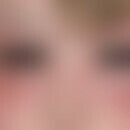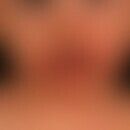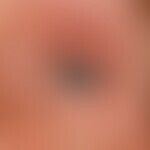Synonym(s)
DefinitionThis section has been translated automatically.
Pathogenetically heterogeneous dermatitis with acute, subacute or (frequently) chronic inflammation of the eyelids, which is essentially characterized by the special anatomical conditions (moist contact situation of the superimposed eyelid folds with reservoir character for toxic or allergenic substances) and functionality of the eyelid organ.
ClassificationThis section has been translated automatically.
Depending on the aetiology of the eczema can be divided:
- eyelid dermatitis, atopic (10-20% of eyelid dermatitis)
- Eyelid dermatitis, contact allergies (about 50% of eyelid dermatitis)
- Airborne Contact Dermatitis (about 2% of eyelid dermatitis)
- Eyelid dermatitis, toxic-irritant (15-20% of eyelid dermatitis)
- Eyelid dermatitis, seborrheic (3-6% of eyelid dermatitis)
- Rare forms:
- Photoallergic eyelid dermatitis (see below light dermatoses)
- Isolated periocular dermatitis (see below perioral dermatitis).
You might also be interested in
Occurrence/EpidemiologyThis section has been translated automatically.
As the etiology of eyelid dermatitis is different, a general number cannot be given. It is known that about 12% of the hypersensitivities to cosmetics lead to an eyelid dermatitis (caused by involuntary transfer).
EtiopathogenesisThis section has been translated automatically.
Etiologically, contact allergens (most frequent cause: in 54.2% of cases eye drops, followed by creams and lotions (24.6%) and various cosmetics (13.1%), a seborrhoeic or atopic diathesis play an important role. Possible triggers see table 1.
ManifestationThis section has been translated automatically.
Atopic eyelid dermatitis can occur in early childhood (together with other atopic stigmas).
Contact allergic eyelid dermatitis manifests itself significantly later, in early or middle adulthood. In a larger study involving 61 patients (Chisholm SAM et al. 2017) the mean age was 66 years (33-94). 74% of the patients were women.
Clinical featuresThis section has been translated automatically.
Mostly chronic dynamic, permanent or recurrent clinical picture, in which a blurred erythema, swelling of the eyelids and itching characterize the picture. Depending on the persistence of the inflammation: scaling, lichenification with distinct thickening of the eyelids, pruritus of rare oozing with crust formation as well as disorders of the eyelid functions (danger of ectropion or ectropion with consecutive consequences for the eye).
In a larger study involving 61 patients (Chisholm SAM et al. 2017), tears (epiphora), ectropion (24.6%), blepharitis (18.0%), ptosis of the eyelids (14.8%) were the cause for the visit to the doctor in 1/3 of the patients.
In rare cases, pruritus may be absent, making it difficult to distinguish it from other diseases, especially thyroid diseases, angioedema, collagenosis, nephropathies, lymphoma of the skin.
DiagnosisThis section has been translated automatically.
- The diagnosis of dermatitis of the eyelids consists primarily in the exclusion of contact allergic dermatitis. The number of undetected contact allergens is high.
- The anamnesis survey plays a major role:
- Perennial eyelid dermatitis: No causation by pollen; eyelid eczema also after prolonged stay outside the own home. Exclusion of indoor allergens is required.
- Seasonal eyelid dermatitis: Cosmetic allergy unlikely.
- In addition to allergens that come into direct contact with the eyelid region (mascara, eye make-up, ophthalmics, contact lens cleaners), substances that come into contact with the eyelid region indirectly (via fingers) (allergen carry-over) often trigger isolated eyelid dermatitis. On average, a person rubs their eyelids 50-100 times/day, often unconsciously. In principle, any substance in the environment can be a trigger.
- Substances applied to other parts of the body may trigger isolated contact dermatitis in the eyelid area without causing reactions at the actual application site (low degree of sensitization or low allergen concentration, but low skin thickness and occlusion effect in the eyelid area).
- A negative epicutaneous test does not exclude contact allergic eyelid dermatitis due to cosmetics.
- Weak reactions in the epicutaneous test to cosmetics may represent genuine sensitisation. If necessary, repeat the test procedure in a " repeated open application test (ROAT)". In this case, the suspicious substance is applied to the inner side of the upper arm twice a day for 1 week. Another possibility to clarify a clinical relevance is the open epicutaneous test in loco.
- Allergens in nail polish (nickel, toluenesulfenamide-formaldehyde resin) cause eyelid and facial eczema, fingers remain free of skin symptoms.
- Allergens can also be "transmitted" by the partner (aftershave of the partner in case of fragrance sensitization).
- In the eyelid area, contact eczema caused by volatile allergens such as type IV allergens(formaldehyde, primin) or type I allergens (pollen, house dust mites) is also possible, see also Airborne Contact Dermatitis.
- According to the regulation, spectacle frames made of "metal" must not release nickel on the surface. However, the core of the spectacles is often still made of nickel, and the release of nickel is therefore possible with ageing and wear.
Differential diagnosisThis section has been translated automatically.
In descending order of frequency, the following diseases can be assigned to the clinical appearance of "eyelid eczema":
- Contact allergy
- Atopic eczema (possibly as a monotopic minus variant)
- Seborrheic ec zema (mostly in connection with other characteristics)
- Rosacea (with eyelid involvement)
- Lichen simplex chronicus
- Herpes simplex recidivans
- Pediculosis (infestation by crabs)
- Impetigo contagiosa
- Psoriasis vulgaris (as a rare monotopic minus variant or involvement of the eyelid area)
- Fixed drug reaction
- Tinea faciei (possibly isolated in the eyelid area)
- Dermatomyositis.
Complication(s)This section has been translated automatically.
TherapyThis section has been translated automatically.
The detection of underlying sensitization and subsequent exposure abstinence is in the foreground of any therapeutic approach!
- In contact allergic dermatitis: elimination of the allergen. In case of atopic genesis there is a tendency to chronicity and resistance to therapy.
- Acute eczema: hydrocortisone: 0.5% in as indifferent a base as possible (Vaselinum alb.) or glucocorticoid-containing eye preparations (e.g. Ficortril eye ointment).
- After the acute phase has subsided: discontinuation of glucocorticoid, local calcineurin inhibitor therapy, e.g. Ikervis® 1 mg/ml 0.3 ml, s.a. Ciclosporin A solution 1-2% (according to Altmeyer); oily ciclosporin eye drops 1 or 2 % ig NRF 15.21; care therapy with eye creams without fragrances and dyes, PEG emulsifiers, wool waxes, mineral oils, silicones, e.g. Benevi neutral® eyelid cream, ointments containing dexpanthenol(e.g. Bepanthen eye ointment Cave! wool wax allergy!) or eye vaseline.
Notice. Higher potent glucocorticoids should be avoided for the eyelid area, danger of steroid atrophy!
- In acutely exacerbated atopic dermatitis, short-term therapy with an external glucocorticoid on an indifferent basis (see below). In case of severe symptoms, internal glucocorticoid administration (prednisolone 1 mg/kg bw), if necessary in combination with an oral antihistamine such as desloratadine (Aerius) 1 time/day 5 mg p.o..
- In chronic atopic dermatitis: It is problematic that in the area of the eye the application of many antieczematous agents is not possible. Short-term hydrocortisone 0.5-1% in as indifferent a base as possible (e.g. Vaselinum album: hydrocortisone ointment 1%). Additionally compresses with cold black tea, Tannolact solution or physiological saline solution (also cool tap water). Application: Apply ointment to eyelids, rest for 20 minutes, apply soaked compresses.
- Alternative to glucocorticoids: Good success (but according to current knowledge no long-term therapy is possible because of the unclear long-term effects) is achieved with intermittent application of topical immunomodulators (e.g. Tacrolimus, Pimecrolimus). However, because of the unknown long-term effects of calcineurin inhibitors and the carcinogenicity of pimecrolimus proven in animal experiments, the indication for therapy with calcineurin inhibitors must be extremely strict!
- Alternative: Magistral prescription of a 1.0-2.0% ciclosporin-containing solution ( R047 ), ready-to-use preparation Ikervis® 1 mg/ml 0.3 ml; or Oily ciclosporin eye drops 1 % / 2 % NRF 15.21
General therapyThis section has been translated automatically.
- Patience of therapist and patient is important. The etiological mechanisms of the present eyelid eczema must be explained to the patient. Avoiding the allergen is to be given the highest priority.
- Cleaning of the eyelids with pure olive oil (apply with cotton wool carrier and dab the eyelids gently). Especially in case of aerogenic contact allergy the cleaning procedures are important (allergen removal especially in the evening!).
- Eyelid edge care: Special care of the possibly encrusted eyelid edges is important. Apply moist compresses (see above); then carefully clean the eyelid margins with a cotton swab.
- Long-term therapy: Nursing measures with indifferent external agents such as simple eye ointment DAC (e.g. R021 ) or emulsifying eye ointment (e.g. R022, R023 ).
Progression/forecastThis section has been translated automatically.
The average duration of symptoms in a larger study was 16.5 months.
NaturopathyThis section has been translated automatically.
TablesThis section has been translated automatically.
Possible triggers of allergic eyelid dermatitis (and facial dermatitis)
Detergents |
soap, washing lotions, face milk, bath additives |
Cosmetics |
Make-up, make-up and its removers, face mask, face creams, shaving foam or water, perfumes, sunscreens, artificial tanning products, refreshing tissues |
Hair Care |
Shampoo, dry shampoo, spray, setting lotion, hair tonic, tinting or colouring agent, cream rinses, hairdressing cream, perm water, cold wave, wig, wig care products (often eyelid eczema combined with facial and head eczema) |
Lip Care |
Lipstick, lipstick ointment |
Eyelash cosmetics |
eyelid and mascara, eye shadow, eyebrow pencil |
Nail Cosmetics |
Nail polish (nickel in metallic nail polish), artificial fingernails, nail polish remover |
Personal care products |
Body lotions, Hand creams, Body spray, Body powder |
Therapeutics, Ophthalmics |
Antiseptics (polyvidon), non-steroidal anti-inflammatory drugs (diclofenac), anaesthetics, glucocorticoids, antibiotics (gentamicin, chloramphenicol), mydriatica, preservatives (benzalkonium chloride, thiomersal), herpes therapeutics, carboanhydrasehalter e.g. dorzolamide (for glaucoma therapy) |
Contact lenses |
general incompatibility with increased lacrimation and consecutive eyelid irritation (usually in stripes around the lateral corners of the eye), contact allergens in cleaning and storage liquids |
Detergents |
among other things fragrances (Peru balsam!) |
occupational allergens, hobby |
according to medical history |
Budget |
metal, floor, car, furniture polish, floor polish, shoe polish, stain remover |
Indoor allergens |
Plants (primroses), room spray, carpet cleaner; house dust mites, animal epithelia (type I sensitisers) |
Note(s)This section has been translated automatically.
LiteratureThis section has been translated automatically.
- Adams RM et al.(1985) A five-year study of cormetic reactions.J Am Acad Dermatol 13:1062-1065.
- Beltrani VS (2001) Eylid dermatitis. Current Allergy and Asthma Reports 1: 380-388.
- Chisholm SAM et al (2017) Etiology and management of allergic eyelid dermatitis. Ophthalmic Plast Reconstr Surg 33:248-250.
- Guin JD (2004) Eyelid dermatitis: a report of 215 patients. Contact Dermatitis 50: 87-90
- Wollenberg A et al (2004) Diagnosis and treatment of eyelid eczema. An interdisciplinary challenge. Dermatologist 55: 677-687
- Zirwas MJ (2019) Contact dermatitis to cosmetics. Clin Rev Allergy Immunol 56:119-128.
Incoming links (19)
Atopy; Atopy; Blepharitis; Ciclosporin a solution 1-2% (according to altmeyer); Cocamidopropyl betaine; Dorzolamide; Eczema, eyelid eczema; Emulsifying eye ointment (pharm. helv. vii); Eyelid dermatitis; Eyelid dermatitis atopic; ... Show allOutgoing links (44)
Airborne contact dermatitis; Angioedema (overview); Atopic dermatitis (overview); Calcineurin inhibitors; Ciclosporin a solution 1-2% (according to altmeyer); Collagenoses; Contact allergy (overview); Contagious impetigo; Cutaneous non hodgkin lymphomas; Dermatitis contact allergic; ... Show allDisclaimer
Please ask your physician for a reliable diagnosis. This website is only meant as a reference.






























